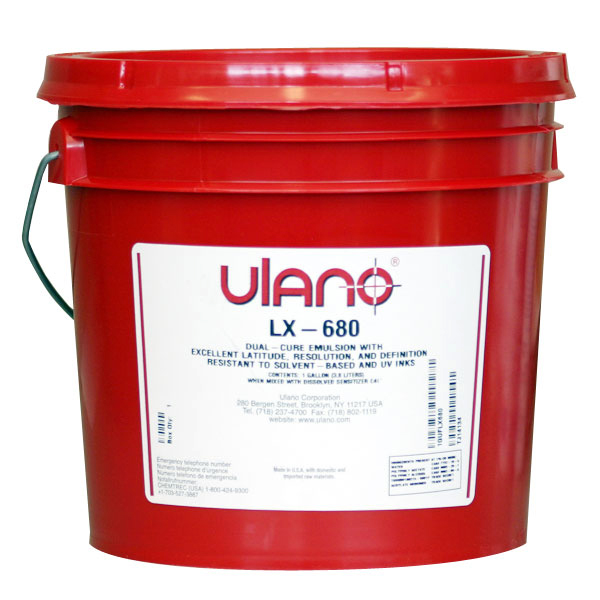HOW TO USE EMULSION:
PREPARE THE FABRIC:
Used or surface treated fabric need only be degreased using Screen Systems Degreaser 5505. (Mechanical roughening is an option for new fabric that is not surface treated. It increases the surface area of fabric for a better mechanical bond of the stencil, increasing printing run length.
SENSITIZE THE EMULSION:
Dual cure emulsions are partially sensitized; therefore, it must be handled under yellow light. Dissolve the diazo sensitizer powder by adding lukewarm water up to the shoulder of the bottle. Shake well. Wait 15 minutes for bubbles to disperse. Pour the fully dissolved sensitizer into the emulsion. Stir with a clean, broad, flat plastic or stainless steel instrument until the emulsion is uniform in color. Close the container. Wait at least one hour for the emulsion to de-bubble.
COAT THE SCREEN:
Use the rounded edge of a scoop coater to apply an even coat of emulsion in one pass. The coater should be at least two inches shorter that the narrow width of your screen.
Method 1:
Apply one coat of emulsion to the printing side, then one coat on the squeegee side. Dry the screen thoroughly.
Method 2:
Apply two coats on the printing side, then two coats on the squeegee side, wet-on-wet. After each coating, rotate the screen 180°. Dry the screen thoroughly. Additional coats can be applied to the print side to optimize definition.
DRY THE SCREEN:
Dry screens thoroughly in a horizontal position, printing side down, at room temperature in a dirt- and dust-free area. Use a fan to accelerate the drying. Avoid high humidity. Under humid conditions, dry the coated screen with warm, filtered air up to 104° F. (40° C.) in a commercial screen dryer. Use a dehumidifier in the drying area is strongly recommended, if possible.
DETERMINE THE OPTIMAL EXPOSURE TIME:
Make a Step Wedge or use an Exposure Calculator KitQcarried through to actual printingQto determine your optimum exposure time. The optimum exposure is when the emulsion first reaches its maximum color density, and the edges of the positive do not "resolve." The squeegee side emulsion is hard, not soft or slimy.
WASHOUT:
Wet both sides of the screen with a gentle spray of cold water. Then spray the printing side forcefully until the image areas clear. Rinse both sides with a gentle spray until no soft emulsion is left on the squeegee side, and no foam or bubbles remain. Blot excess water from the printing side with unprinted newspaper stock.
BLOCKOUT & TOUCHUP:
Blockout
Before drying and exposure, use excess emulsion from the coating step to cover the blockout area. For non-water-based inks, after exposure and washout, dry the screen. Apply Screen Systems No. 5511 with a plastic applicator squeegee of 14 ply cardboard.
Touchup
Use excess emulsion and re-expose the screen. For non-water-based inks, use Screen System 5511 blockout thinned with equal parts water and isopropyl alcohol and apply with a spotting brush. A block out pen will also work.
STENCIL REMOVAL:
Remove ink from the screen using a solvent. Screen Systems Biodegradable solvent 2500 or 2550 will remove almost all inks.. Brush Stencil Remover Liquid No. 6000 on both sides of the screen. Do not let the stencil remover dry on the screen. Wash the screen with a forceful spray of water. Use Haze Remover 5230 to remove ink and haze residues, if necessary.
